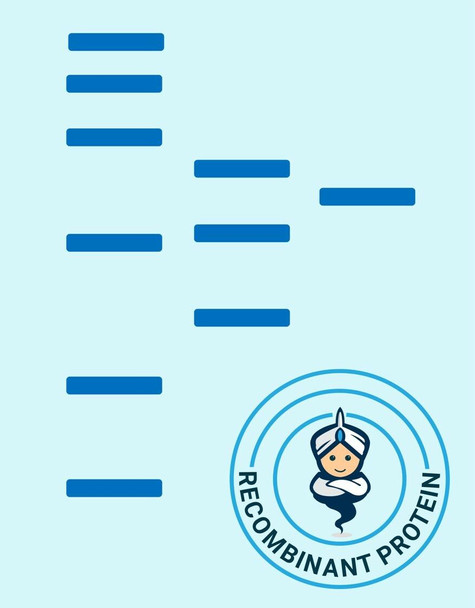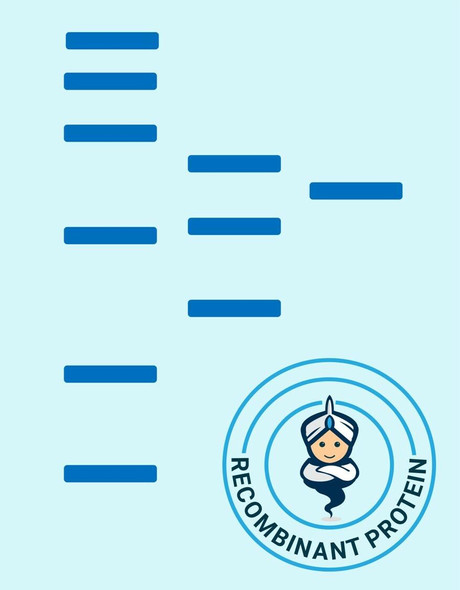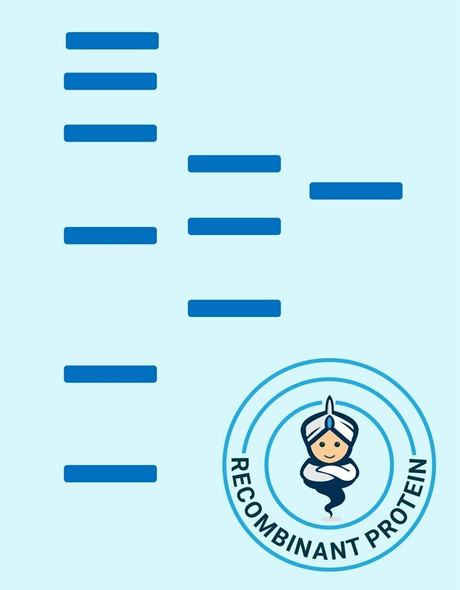Human PIP Recombinant Protein (RPPB0900)
- SKU:
- RPPB0900
- Product type:
- Recombinant Protein
- Size:
- 10ug
- Species:
- Human
- Target:
- PIP
- Synonyms:
- Prolactin-inducible protein
- Gross cystic disease fluid protein 15
- GCDFP-15
- Prolactin-induced protein
- Source:
- Human Seminal Plasma
- Uniprot:
- P12273
Description
| Product Name: | Human PIP Recombinant Protein |
| Product Code: | RPPB0900 |
| Size: | 10µg |
| Species: | Human |
| Target: | PIP |
| Synonyms: | Prolactin-inducible protein, Gross cystic disease fluid protein 15, GCDFP-15, Prolactin-induced protein, Secretory actin-binding protein, SABP, gp17, PIP, GCDFP15, GPIP4. |
| Source: | Human Seminal Plasma |
| Physical Appearance: | Filtered White lyophilized (freeze-dried) powder. |
| Formulation: | PIP protein filtered (0.4µm) and lyophilized in 0.5mg/ml in 0.05M phosphate buffer and 0.075M NaCl pH 8.0. |
| Solubility: | It is recommended to add deionized water to prepare a working stock solution of approximately 0.5 mg/ml and let the lyophilized pellet dissolve completely. PIP is not sterile! Please filter the product by an appropriate sterile filter before using it in the cell culture. |
| Stability: | Store lyophilized protein at -20°C. Aliquot the product after reconstitution to avoid repeated freezing/thawing cycles. Reconstituted protein can be stored at 4°C for a limited period of time; it does not show any change after two weeks at 4°C. |
| Purity: | Greater than 95% as determined by SDS-PAGE. |
| Amino Acid Sequence: | QDNTRKIIIK NFDIPKSVRP NDEVTAVLAV QTELKECMVV KTYLISSIPL QGAFNYKYTA CLCDDNPKTF YWDFYTNRTV QIAAVVDVIR ELGICPDDAA VIPIKNNRFY TIEILKVE |
Prolactin inducible protein (PIP) is a 17kDa glycoprotein existing in human seminal plasma. PIP is synthesized as a 146 amino acid long polypeptide exhibiting high sequence similarity with mouse submaxillary gland with a single glycosylation site. The precise biological functions of PIP are still ambiguous but various functions have been assigned to PIP due its existence at high concentration in biological fluids. PIP binds to various proteins such as fibrinogen, actin, keratin, myosin and tropomyosin. PIP is also expressed in pathological conditions of the mammary gland and in some exocrine tissues, such as the lacrimal, salivary and sweat glands. Due to PIP’s association with secretory cell differentiation, it has been used in diagnostic evaluation of tumors of breast, salivary gland, and skin.
The Prolactin-Induced Protein produced from Human Seminal Plasma has a molecular mass of 13.52kDa (calculated without glycosylation) containing 118 amino acid residues.
| UniProt Protein Function: | PIP: Belongs to the PIP family. |
| UniProt Protein Details: | Protein type:Secreted, signal peptide; Cytoskeletal; Secreted Chromosomal Location of Human Ortholog: 7q34 Cellular Component: extracellular region; extracellular space; nucleus Molecular Function:aspartic-type endopeptidase activity; glycoprotein binding; IgG binding; protein binding; protein dimerization activity Biological Process: detection of chemical stimulus involved in sensory perception of bitter taste; proteolysis; retinal homeostasis; transmembrane transport |
| UniProt Code: | P12273 |
| NCBI GenInfo Identifier: | 134170 |
| NCBI Gene ID: | 5304 |
| NCBI Accession: | P12273.1 |
| UniProt Secondary Accession: | P12273,A0A963, A0A9C3, A0A9F3, A4D2I1, |
| UniProt Related Accession: | P12273 |
| Molecular Weight: | 16,572 Da |
| NCBI Full Name: | Prolactin-inducible protein |
| NCBI Synonym Full Names: | prolactin induced protein |
| NCBI Official Symbol: | PIP |
| NCBI Official Synonym Symbols: | GPIP4; GCDFP15; GCDFP-15 |
| NCBI Protein Information: | prolactin-inducible protein |
| UniProt Protein Name: | Prolactin-inducible protein |
| UniProt Synonym Protein Names: | Gross cystic disease fluid protein 15; GCDFP-15; Prolactin-induced protein; Secretory actin-binding protein; SABP; gp17 |
| Protein Family: | Proline iminopeptidase |
| UniProt Gene Name: | PIP |
| UniProt Entry Name: | PIP_HUMAN |










